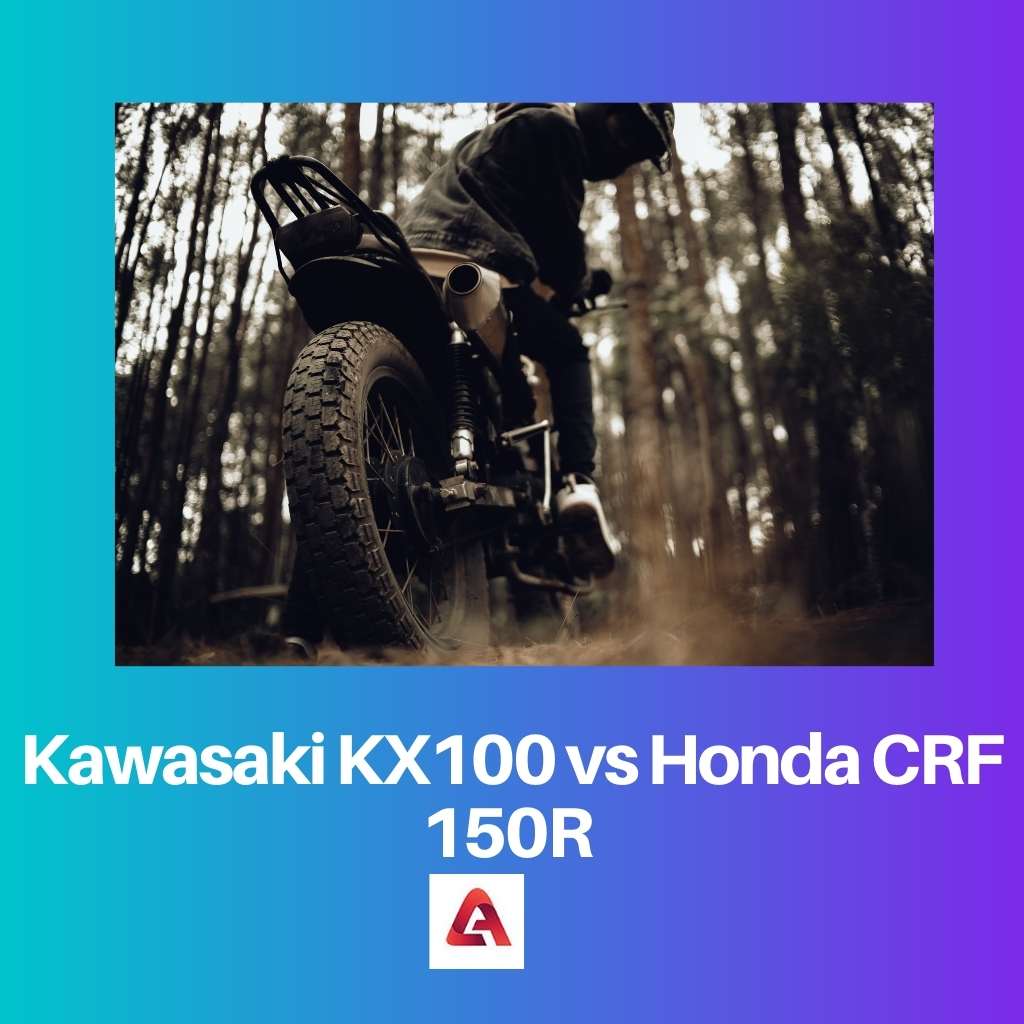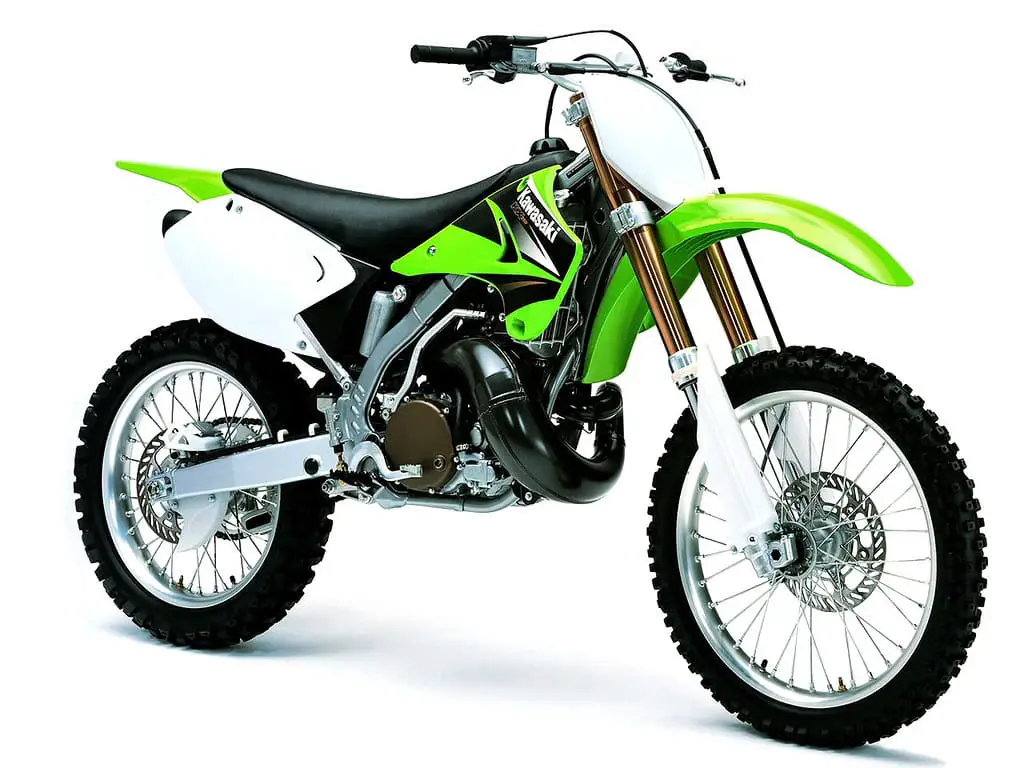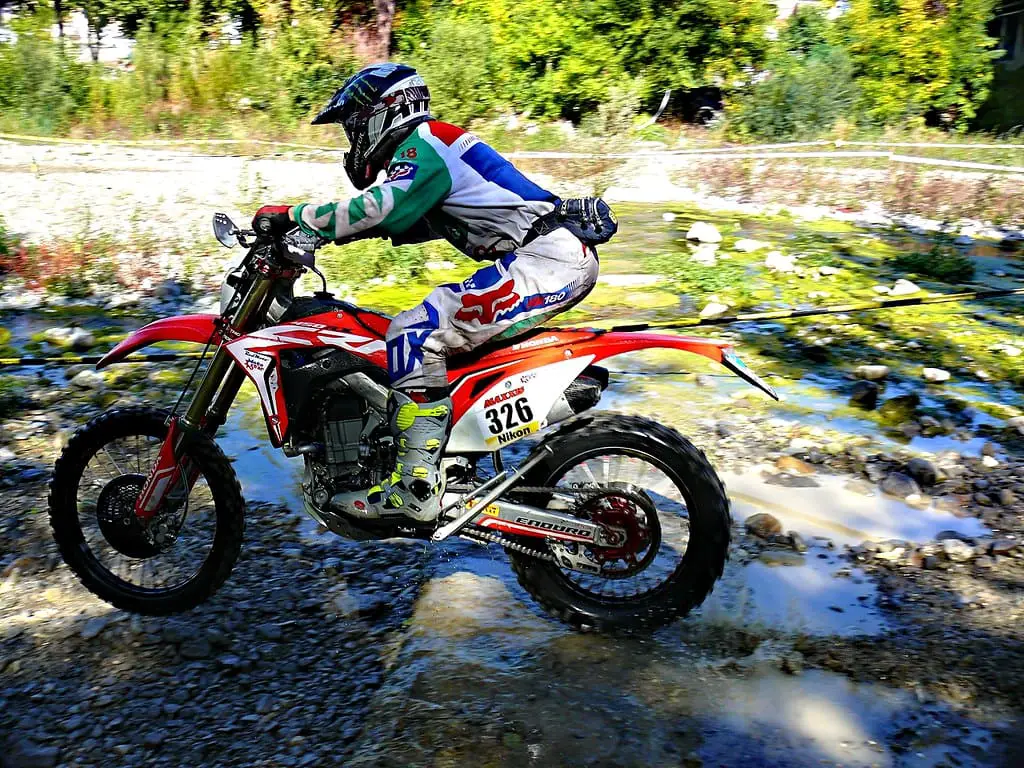Dirt bikes are used mainly for racing purposes. They are available in two types of engine two-stroke engines and four-stroke engines. These lightweight bikes have an intense kick associated with the motor.
The two most popular dirt bike models available are Kawasaki KX 100 and Honda CRF 150R.
Key Takeaways
- The Kawasaki KX100 is a lighter motorcycle, weighing 169.7 lbs, whereas the Honda CRF150R weighs 187 lbs, making the KX100 easier to maneuver.
- The KX100 has a 99cc engine, while the CRF150R has a larger 149cc engine, providing greater power and performance than the Honda model.
- Both motorcycles are designed for off-road use, but the CRF150R has a more advanced suspension system, offering improved handling and stability.
Kawasaki KX100 vs Honda CRF 150R
The Kawasaki KX100 is a smaller motocross bike designed for younger riders or those with less experience. It has a 99cc two-stroke engine that produces quick acceleration and high speeds. The Honda CRF150R is a more advanced motocross bike designed for experienced riders. It has a 149cc four-stroke engine produces more power and torque than the KX100.

The transmission type in Kawasaki KX 100 is six-speed. It has a 99 cc engine which is a two-stroke type. The availability of colour variant in the Kawasaki KX 100 is green.
The fuel capacity offered by the motocross is 5.3 L.
On the other hand, Honda CRF 150R has a five-speed manual type transmission. It has a 147.7 cc engine which is of two-stroke type. The availability of the colour variant in the Honda CRF 150R is red.
The fuel capacity offered by the motocross is 4.31 L.
Comparison Table
| Parameters of Comparison | Kawasaki KX 100 | Honda CRF 150R |
|---|---|---|
| Number of gears | 6 speed | 5 speed |
| Seat height | 870 mm | 860 mm |
| Tyre size front | 24.6 / 100 – 70 | 70/100-19 |
| Tyre size rear | 23.1 / 100- 90 | 90/100-16 |
| Bore × Stroke | 52.5 mm × 45.8 mm | 66.0 mm × 43.7 mm |
What is Kawasaki KX 100?
Kawasaki KX 100 belongs to the family of dirt bikes with a water-cooled single unit. It has a 99 cc engine which is a two-stroke type. The bike has 19-inch front wheels, and the rear wheels are 16 inches.
The transmission type in Kawasaki KX 100 is six-speed. The seat height of the vehicle is 870 mm or around 34.3 inches. The two-stroke racing engine can be changed for increased torque and power performance.
The motorcycle has a disc-type brake switch positioned as two pistons in the front and one piston in the rear. The fuel capacity offered by Kawasaki KX 100 is 5.3 L.
The vehicle’s race can be done in dedicated 100 cc classes of motocross or even in open mini-cycle classes. The classes should allow up to 85cc-112cc in 2 strokes or 150cc in 4 strokes.
The engine of the Kawasaki KX 100 has only one cylinder. The tire size in the front is 24.6 / 100 – 70 and in the rear is 23.1 / 100- 90. The type of tires used in the vehicle is tubeless.
The valve system used in the vehicle is a piston reed valve. It has a cooling system that is cooled through the liquid. The car provides big bike performance in a pinned-sized package, especially for young riders.
The handlebar of the Kawasaki KX 100 is six-position and is an adjustable mount. This helps the riders to tailor their ergonomics during riding. The suspension components are easily adjustable in the motocross bike.
The total weight of the bike is around 77 kg. The gearbox of the vehicle is six-speed. The car is widely available in green colour.

What is Honda CRF 150R?
Honda CRF150R Belongs to the family of the dirt bike. It was released by Honda in the year 2006. It is a two-stroke bike with an engine of 85 ccs or 5.2 CU.
The vehicle’s racing is not done in mini-class or stock class and is raced in Supermini class. It is considered one of the best mini-racing bikes that Honda has manufactured.
The motocross has a four-valve engine that is cooled through a liquid cooling system and produces power at a wide range of RPM. It has a Showa suspension which is completely adjustable.
The tires of the Honda CRF 150R are of high-quality Dunlop type. It is the predecessor of the Honda CR 85R. The vehicle has a five-speed manual type transmission.
The engine is 149 cc or 9.1 CU which has a liquid-cooled single-cylinder. The suspension type in the front is 37 mm of Showa fork, and in the rear is a single 190 mm disc.
The tires in the front are 70/100-19, and in the rear are 90/100-16. The fuel capacity offered by the vehicle is 1.14 gallons. The wheelbase of the Honda CRF 150R is 1290 mm or around 50.6 inches.
The seat height of the motocross is 830 mm or 32.8 inches on the small wheel and 860 mm or 34.0 inches on the big wheel.
Additional features like a larger wheelbase, taller seat height, longer swingarm, higher ground clearance, increased tire size, and a larger rear sprocket can be customized and added to the vehicle with extra charges.

Main Differences Between Kawasaki KX 100 and Honda CRF 150R
- The colour variant of Kawasaki KX 100 is green, while the colour variant of the Honda CRF 150R is red.
- The engine capacity of the Kawasaki KX 100 is 99 cc while the engine capacity of the Honda CRF 150R is 147.7 cc.
- The maximum power of Kawasaki KX 100 is 30 PS@9000 rpm, while the maximum power produced by Honda CRF is 23.47 PS @ 12500 rpm.
- The fuel tank size of the Kawasaki KX 100 is 5 liters while the fuel tank size of the Honda CRF 150R is 4.16 L.
- The curb weight of the Kawasaki KX 100 is 77 kg, while the curb weight of the Honda CRF 150R is 84.82 kg.

It’s great to know the detailed comparison between the Kawasaki KX100 and Honda CRF150R. The post gives a clear understanding of the technical specifications, and specifies the differences between the two models. Now I have a better understanding of what bike would suit me best. This is a highly informative post.
Frankly, I find this post to be overly technical and detailed for the average reader. Not everyone is interested in the nitty-gritty of dirt bike engineering. I would appreciate a more simplified version that captures the essence of the comparison without drowning the reader in technicalities.
The content seems to be good, but it fails to mention any drawbacks of either of the dirt bikes. It would be more balanced if it highlighted both the positives and negatives of the Kawasaki KX100 and Honda CRF150R. A more comprehensive review would make the comparison fairer.
I disagree. The purpose of the post seems to be providing an overview of the Kawasaki KX100 and Honda CRF150R models. It successfully achieves this by laying out their specifications and key differences in a clear, easy-to-understand manner. The focus here is comparison, not critique.
This article is as helpful as a cold shower on a winter’s morning! I’m not much of a bike enthusiast, but this post managed to engage me with its detailed information and technical comparisons. I couldn’t help but read it till the end.
I’m with you on that. It’s not often that a post on dirt bikes appeals to someone with no interest in the subject matter. But this one surely did. Kudos to the writer for making a seemingly niche topic quite engrossing!
This is a helpful and comprehensive comparative review of dirt bikes. It provides all the necessary details one would need to know before buying a dirt bike. In my opinion, the analysis has been well-researched and presented in a very concise manner. Both bikes have their own pros and cons, and the post does a great job of highlighting them.
The author seems to have a clear bias towards the Kawasaki KX100. The language used to describe it is more positive as compared to the Honda CRF150R. This leads to a skewed comparison and does not provide a fair assessment of both the dirt bikes.